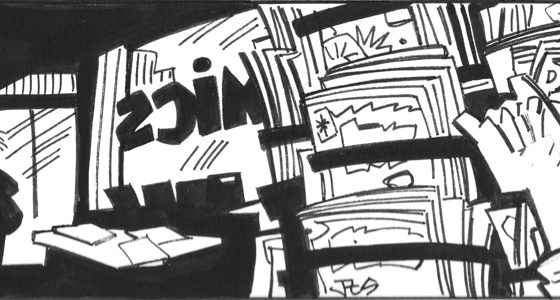One of the most distinctive rituals at DC in the early 1970s was the walk down the aisle to get a cover designed. The newsstand was still virtually the only form of distribution of comics in America, and conventional wisdom held that the cover was by far the most important aspect of a comics’ sales potential other than the main character. By the time I started as an assistant editor, Carmine Infantino had been designing almost all of DC’s covers for several years; a responsibility he took on in his first staff position as art director in the late ’60s and kept with each promotion. Was it was more important in his view than any alternative business task, or simply more comfortable? Probably a combination of the two, and there’s no question he was extraordinarily skilled at the task.
One or another of the editors would walk down the corridor, a complete inked issue or perhaps two under his arm (by my time on staff Dorothy Woolfolk had left, and the next woman to be named a full editor (Karen Berger) wouldn’t get that title until 5 years after Carmine’s departure. Carmine preferred to use the cover design meeting to thumb through the pages, looking for visual drama or potential, and occasionally to use the opportunity to conduct a bit of quality control.
Most often, after a brief look and perhaps a short discussion with the editor, Carmine would pick up a ball-point pen and a sheet of bond typing paper, and start sketching. The aspect ratio of the typing paper was off that of a comic cover, but his compositions were often such dynamic constructions that they survived the adjustments that would be made by the pencil artist who would actually render the cover. Those artists who most often did the covers were used to Carmine’s structural compositions (more like a large thumbnail than a rough sketch), and could bring them to life beautifully; just look at the powerful pieces created by Joe Kubert or Neal Adams this was, or the beauty of Nick Cardy’s covers from the period.
Since a couple of the editors were amazing artists in their own right, once in a while the sketching process became an artistic duel, or a layered collaboration (a SWAMP THING sketch by Carmine much overlaid by Joe Orlando survived and has been reprinted a couple of times as an example of this).
Once in a while, though, it was quality control time. Anthology mystery books occasionally were sent back in their editor’s arms to be remixed, another, perhaps more visual story to be chosen from inventory in place of one of the proposed tales. The inventory of the two principal mystery editors of the day (Joe Orlando and Murray Boltinoff) was deep, so this wasn’t a major setback.
More frustrating (and far rarer) were moments like the classic discussion of SECRET SOCIETY OF SUPER-VILLAINS #1, during which Carmine looked through the issue in search of the villains’ headquarters, and finding none, sent editor Gerry Conway back to have the already finished issue redone to include one. (The earlier version has been reprinted a couple of times, and you can make your own decision about whether it was improved by the guidance.) Or when Carmine read my original dialogue for an Aquaman lead for ADVENTURE COMICS, and decided I wasn’t ready for the task. David Michelinie was given the polishing job, and it became a rare Jim Aparo job that didn’t carry his lettering, with Ben Oda’s balloons pasted in over the originals. Looking back at my work of the period (I haven’t ever had the courage to look at the script that was redone and compare), I’m sympathetic to Carmine’s judgment. I was probably still a member of the ‘Not Ready For Prime Time Players.’
There were also are moments when an editor would simply march down the hall carrying a cover, fully illustrated and submitted on spec by an artist with no connection to any specific issue. Only a handful of artists did this: Neal Adams, Bernie Wrightson and Mike Kaluta come to mind. Sometimes a story would be crafted around the image, or the cover might run without a specific story connected to it (most often on a mystery title).
Covers actually had the most time-consuming production and printing process of any part of a comic at this time, so designing the cover last potentially put pressure on. But most of the line was on a production schedule that allowed this painlessly, and to my recollection, no comic ever shipped late as a result.
Here svoboda28.com you find oil painting for sale in a very good price. Amazing oil painting for decorate your home

Love these little glimpses into comics history. Late 70’s to late 80’s DC is my favourite era, and this was a great article.
Carmine sure seems to divide opinion to this day.
Thanks for sharing